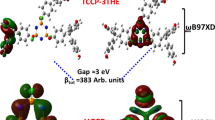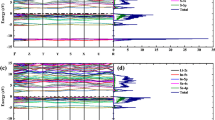Abstract
In the present investigation, we use a dual computational approach (at single molecular and solid-state levels) to explore the optoelectronic and nonlinear optical (NLO) properties of cross-shaped derivatives. The solid-state electronic band structures of the compounds 1–3 (the derivatives of tetracarboxylic acid in cross-shaped having the core of benzene (1), pyrazinoquinoxaline (2), and tetrathiafulvalene (3)) are calculated. The calculated band gaps for compounds 1–2 are found to be direct bad gaps and compound 3 to be indirect bad gap with energy gaps of 2.749, 1.765, and 0.875 eV, respectively. The important optical properties including refractive index, absorption coefficients, loss functions, and extinction coefficient of these semiconductors are calculated at bulk level to seek their potential applications as efficient optoelectronic materials. Additionally, we use the Lorentz approximation to calculate the third-order NLO susceptibilities of compounds 1–3 using the molecular hyperpolarizability and solid-state parameters. The calculated third-order NLO susceptibilities of compounds 1–3 are found to be 6.92 × 10−12, 64.0 × 10−12, and 26.3 × 10−12 esu, respectively. Thus, the present study not only provides a way to connect the calculated third-order molecular NLO polarizability to NLO susceptibilities for compounds 1–3 through Lorentz approximation but also highlights the importance of central core modifications on their NLO susceptibilities.
Graphical abstract










Similar content being viewed by others
References
Lin Q, Armin A, Nagiri RCR, Burn PL, Meredith P (2015) Electro-optics of perovskite solar cells. Nat Photonics 9:106
Forrest SR (2000) Active optoelectronics using thin-film organic semiconductors. IEEE J Sel Top Quantum Electron 6:1072–1083
Mhibik O, Forget S, Ott D, Venus G, Divliansky I, Glebov L et al (2016) An ultra-narrow linewidth solution-processed organic laser. Light Sci Appl 5:e16026
Brabec CJ (2004) Organic photovoltaics: technology and market. Sol Energy Mater Sol Cells 83:273–292
Hasegawa H, Sato T (2005) Electrochemical processes for formation, processing and gate control of III–V semiconductor nanostructures. Electrochim Acta 50:3015–3027
Ruiz C, García-Frutos EM, Hennrich G, Gómez-Lor B (2012) Organic semiconductors toward electronic devices: high mobility and easy processability. J Phys Chem Lett 3:1428–1436
Cheng C, Zhu C, Huang B, Zhang H, Zhang H, Chen R et al (2019) Processing halide perovskite materials with semiconductor technology. Adv Mater Technol 4:1800729
Steigerwald ML, Brus LE (1990) Semiconductor crystallites: a class of large molecules. Acc Chem Res 23:183–188
Jackson TN, Lin Y-Y, Gundlach DJ, Klauk H (1998) Organic thin-film transistors for organic light-emitting flat-panel display backplanes. IEEE J Sel Top Quantum Electron 4:100–104
Bharathi MD, Bhuvaneswari R, Srividya J, Vinitha G, Prithiviraajan R, Anbalagan G (2018) Synthesis, optical, experimental and theoretical investigation of third order nonlinear optical properties of 8-hydroxyquinolinium 2-carboxy-6-nitrophthalate monohydrate single crystal. J Phys Chem Solids 113:50–60
Irfan A, Chaudhry AR, Al-Sehemi AG, Assiri MA, Hussain A (2019) Charge carrier and optoelectronic properties of phenylimidazo [1, 5-a] pyridine-containing small molecules at molecular and solid-state bulk scales. Comput Mater Sci 170:109179
Chaudhry AR, Haq BU, Muhammad S, Laref A, Irfan A, Algarni H (2019) Structural, electronic and optical properties of furan based materials at bulk level for photovoltaic applications: a first-principles study. Comput Theor Chem 1147:20–28
Muhammad S, Chaudhry AR, Al-Sehemi AG (2017) A comparative analysis of the optical and nonlinear optical properties of cross-shaped chromophores: quantum chemical approach. Optik. 147:439–445
Frisch MJ, Trucks GW, Schlegel HB, Scuseria GE, Robb MA, Cheeseman JR et al Gaussian 09; Gaussian, Inc: Wallingford, CT, 2009. Gaussian 09; Gaussian, Inc: Wallingford, CT, 2009
Segall M, Lindan PJ, Probert MA, Pickard CJ, Hasnip PJ, Clark S et al (2002) First-principles simulation: ideas, illustrations and the CASTEP code. J Phys Condens Matter 14:2717
Cardona M, Pollak F (1971) Optical properties and model density of states. The physics of opto-electronic materials. Springer 81–112. https://doi.org/10.1007/978-1-4684-1947-4_4
Volovik G (1993) Superconductivity with lines of gap nodes: density of states in the vortex. Inst. Teoreticheskoj Fiziki 58(5–6):457–461
Clark SJ, Segall MD, Pickard CJ, Hasnip PJ, Probert MI, Refson K et al (2005) First principles methods using CASTEP. Z Kristallogr Cryst Mater 220:567–570
Press WH, Vetterling W, Teukolsky SA, Flannery BP, Greenwell Yanik E (1994) Numerical recipes in fortran--the art of scientific computing. SIAM Rev 36:149
Bhattacharya B, Sarkar U (2016) The effect of boron and nitrogen doping in electronic, magnetic, and optical properties of graphyne. J Phys Chem C 120:26793–26806
Bhattacharya B, Paul D, Sarkar U (2019) Electronic and optical properties of XN-ynes (X= B, Al, Ga): a first-principle study with many-body effects. Appl Surf Sci 495:143612
Samantaray C, Sim H, Hwang H (2005) The electronic structures and optical properties of BaTiO3 and SrTiO3 using first-principles calculations. Microelectron J 36:725–728
Okoye C (2003) Optical properties of the antiperovskite superconductor MgCNi3. J Phys Condens Matter 15:833
Hisaki I, Affendy NE, Tohnai N (2017) Precise elucidations of stacking manners of hydrogen-bonded two-dimensional organic frameworks composed of X-shaped π-conjugated systems. CrystEngComm. 19:4892–4898
De Vos A (1980) Detailed balance limit of the efficiency of tandem solar cells. J Phys D Appl Phys 13:839
Ünlü H (1992) A thermodynamic model for determining pressure and temperature effects on the bandgap energies and other properties of some semiconductors. Solid State Electron 35:1343–1352
So FF, Forrest SR (1989) Organic-on-inorganic semiconductor photodetector. IEEE Trans Electron Devices 36:66–69
Acharyya P, Pal P, Samanta PK, Sarkar A, Pati SK, Biswas K (2019) Single pot synthesis of indirect band gap 2D CsPb 2 Br 5 nanosheets from direct band gap 3D CsPbBr 3 nanocrystals and the origin of their luminescence properties. Nanoscale. 11:4001–4007
Paul D, Deb J, Bhattacharya B, Sarkar U (2018) Electronic and optical properties of C 24, C 12 X 6 Y 6, and X 12 Y 12 (X= B, Al and Y= N, P). J Mol Model 24:204
Bhattacharya B, Deb J, Sarkar U (2019) Boron-phosphorous doped graphyne: a near-infrared light absorber. AIP Adv 9:095031
Bessler R, Duerig U, Koren E (2019) The dielectric constant of a bilayer graphene interface. Nanoscale Adv 1:1702–1706
Dimitrakopoulos C, Purushothaman S, Kymissis J, Callegari A, Shaw J (1999) Low-voltage organic transistors on plastic comprising high-dielectric constant gate insulators. Science. 283:822–824
Iqbal J, Yahia I, Zahran H, AlFaify S, AlBassam A, El-Naggar A (2016) Linear and non-linear optics of nano-scale 2′, 7′ dichloro-fluorescein/FTO optical system: Bandgap and dielectric analysis. Opt Mater 62:527–533
Bakulin AA, Rao A, Pavelyev VG, van Loosdrecht PH, Pshenichnikov MS, Niedzialek D et al (2012) The role of driving energy and delocalized states for charge separation in organic semiconductors. Science. 335:1340–1344
Yang D, Ma D (2019) Development of organic semiconductor photodetectors: from mechanism to applications. Adv Opt Mater 7:1800522
Lehmuskero A, Kuittinen M, Vahimaa P (2007) Refractive index and extinction coefficient dependence of thin Al and Ir films on deposition technique and thickness. Opt Express 15:10744–10752
Cardona M (1961) Fundamental reflectivity spectrum of semiconductors with zinc-blende structure. J Appl Phys 32:2151–2155
Knupfer M, Fink J, Fichou D (2001) Strongly confined polaron excitations in charged organic semiconductors. Phys Rev B 63:165203
Brik M (2010) First-principles calculations of electronic, optical and elastic properties of ZnAl2S4 and ZnGa2O4. J Phys Chem Solids 71:1435–1442
Deb J, Paul D, Sarkar U (2020) Density functional theory investigation of nonlinear optical properties of T-graphene quantum dots. J Phys Chem A 124:1312–1320
Kubodera K, Kobayashi H (1990) Determination of third-order nonlinear optical susceptibilities for organic materials by third-harmonic generation. Mol Cryst Liq Cryst 182:103–113
Kafafi Z, Lindle J, Pong R, Bartoli F, Lingg L, Milliken J (1992) Off-resonant nonlinear optical properties of C60 studied by degenerate four-wave mixing. Chem Phys Lett 188:492–496
Kiran AJ, Chandrasekharan K, Nooji SR, Shashikala H, Umesh G, Kalluraya B (2006) χ (3) measurements and optical limiting in dibenzylideneacetone and its derivatives. Chem Phys 324:699–704
Mathew E, Salian VV, Joe IH, Narayana B (2019) Third-order nonlinear optical studies of two novel chalcone derivatives using Z-scan technique and DFT method. Opt Laser Technol 120:105697
Muhammad S, Shehzad RA, Iqbal J, Al-Sehemi AG, Saravanabhavan M, Khalid M (2019) Benchmark study of the linear and nonlinear optical polarizabilities in proto-type NLO molecule of para-nitroaniline. J Theor Comput Chem 1950030
Acknowledgments
The authors from the King Khalid University extend their appreciations to Deanship of Scientific Research at King Khalid University for funding the work through the general research project (RGP2-109-41).
Funding
Shabbir Muhammad, Abdullah G. Al-Sehemi, and Zouhaier Aloui acknowledge the funding from Deanship of Scientific Research at King Khalid University, Saudi Arabia.
Author information
Authors and Affiliations
Contributions
Rao Aqil Shehzad and Shabbir Muhammad conceived the research idea while Javed Iqbal and Abdullah G. Al-Sehemi helped in performing calculations. Muhammad Yaseen, Zouhaier Aloui, and Muhammad Khalid have contributed in interpretations, plotting, and writing of results, respectively.
Corresponding authors
Ethics declarations
Conflict of interest
The authors declare that they have no conflict of interest.
Ethics approval
No animal/human data is used here.
Consent for publication and participation
The consent of all authors and institutes is obtained for publication of present work.
Data transparency
All authors acknowledge that all data of present paper as well as software applications and code availability support their published claims and comply with field standards.
Additional information
Publisher’s note
Springer Nature remains neutral with regard to jurisdictional claims in published maps and institutional affiliations.
Supplementary information
ESM 1
(DOCX 23 kb)
Rights and permissions
About this article
Cite this article
Shehzad, R.A., Muhammad, S., Iqbal, J. et al. Exploring the optoelectronic and third-order nonlinear optical susceptibility of cross-shaped molecules: insights from molecule to material level. J Mol Model 27, 12 (2021). https://doi.org/10.1007/s00894-020-04619-7
Received:
Accepted:
Published:
DOI: https://doi.org/10.1007/s00894-020-04619-7




